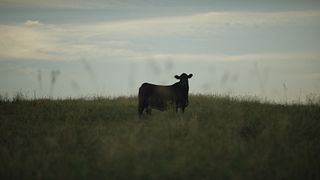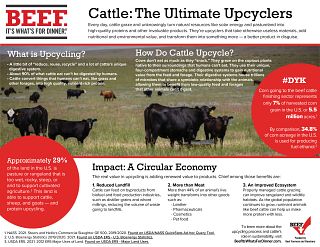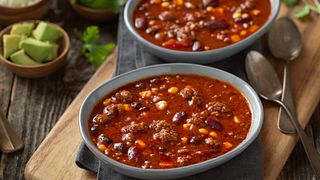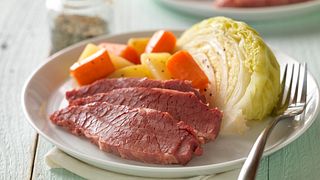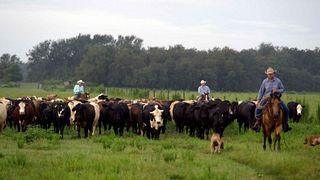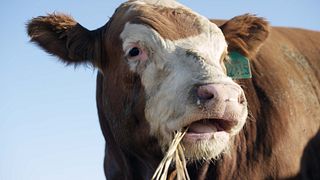cattle: The Ultimate "Upcyclers"
What is “upcycling”? When cattle graze, their ruminant digestive system turns things humans can’t eat, like grass, other forages, and byproducts - such as distillers grain, cottonseed, and beet pulp - into high quality protein and micronutrients for human consumption – a process called upcycling.
Cattle ranching is the perfect example of “upcycling.” Cattle graze on grasslands turning natural resources like pastureland and solar energy into beef and other everyday products. They are upcyclers that take otherwise useless materials, add nutritional and environmental value, and transform them into a high-quality protein and essential micronutrients. In fact, the U.S. beef industry produces more than three-times more high-quality protein for the U.S. food supply than cattle consume.1
How do Cattle Upcycle?
About 90% of what cattle eat can’t be digested by humans, making them invaluable to a sustainable food system. Cattle consume plants that humans can’t eat and through their unique digestive system, transform these plants into a high-quality, nutrient-rich protein. In addition to the grasses they graze on for most of their lives, cattle can eat numerous other food byproducts. They can take items like brewers’ grains, pea pulp, beet tops, and potato peelings and turn those products into beef.
By using byproducts that would otherwise go to waste, cattle are enhancing the sustainability of other industries. For example, cattle eat distillers grains from the corn ethanol industry, cottonseed that is a byproduct of cotton production, and beet pulp that is a byproduct of sugar beet production.
Approximately 29% of the land in the United States is too wet, rocky, steep, or arid to support cultivated agriculture.2 However, cattle graze on plants native to their surroundings that humans can’t eat. Their unique, four-compartment stomach and digestive system is home to trillions of microbes. These microbes allow cattle to benefit and gain nutritional value from these sources that other animals can’t digest.
Approximately 29% of the land in the U.S. is pasture or rangeland that is too wet, rocky, steep, or arid to support cultivated agriculture. This land is able to support cattle, sheep, and goats— and protein upcycling.
The Value of Upcycling
- Upcycling adds additional value to products that otherwise would’ve been wasted.
- Byproducts from biofuel and food production industries, such as distillers grains and beet pulp, are digestible by cattle, reducing the volume of waste going to landfills.
- Properly managed cattle grazing can improve rangeland and wildlife habitats.
- As the global population continues to grow, ruminant animals like beef cattle can help us make more food with less.
- More than 44% of an animal’s live weight transforms into other goods such as leather, cosmetics and pet food.
Corn going to the grain-finished cattle represents only 7% of harvested corn grain in the U.S. or 5.5 million acres.3 By comparison, 34.8% of corn acreage in the U.S. is used for producing fuel ethanol.4
Reduce Landfill Waste
Cattle’s ability to upcycle also helps reduce landfill waste. For every 100lb of human food from crops, there are 37lb (or 7%) of plant leftovers produced, which cattle can then upcycle into protein, micronutrients, and other important products.5,6,7
This is important because municipal solid waste landfills accounted for 14% of methane emissions in the U.S. in 2017, making them the third-largest source of human-related methane emissions in the United States.8,9
Subscribe to our newsletter so you don't miss the best recipes, cooking tips, and more.
Privacy Policy- Baber, J.R. et al., 2018. Estimation of human-edible protein conversion efficiency, net protein contribution, and enteric methane production from beef production in the United States. Trans. Anim. Sci. 2: 439-450
- USDA ERS. 2021. 2012 ERS Major Uses of Land. Found on USDA ERS - Major Land Uses.
- NASS. 2021. Steers and Heifers Commercial Slaughter GE 500, 2019/2020. Found on USDA/NASS QuickStats Ad-hoc Query Tool.
- U.S. Bioenergy Statistics 2019/2020. 2021. Found on USDA ERS - U.S. Bioenergy Statistics.
- Fadel, J.G. Anim. Feed Sci. Technol. 79: 255-268.
- CAST. 1999. Animal agriculture and global food supply. Task force report No. 135, July 1999.
- Rotz et al. 2019. Ag Systems. 169:1-13.
- EPA. 2019. Inventory of U. S. Greenhouse Gas Emissions and Sinks: 1990-2017. U. S. Environmental Protection Agency, Washington, D. C.
- USDA. https://www.usda.gov/foodlossandwaste/why
